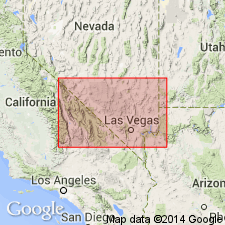
- Usage in publication:
-
- Echo Shale Member*
- Modifications:
-
- Original reference
- Adopted
- Dominant lithology:
-
- Shale
- Limestone
- AAPG geologic province:
-
- Great Basin province
Summary:
Pg. 13. Echo Shale Member of Carrara Formation. Name proposed for the 3rd from lowermost member (of 9). Present in southeastern California and southern Nevada. Consists of green, platy, generally unfossiliferous micaceous shale with brown and orange calcareous intervals or interbedded limestone. Thickness ranges from <1 to 42 m. Overlies Thimble Limestone Member (new) and gradationally underlies Gold Ace Limestone Member (new), both of Carrara Formation; is inseparable from Pyramid Shale Member (new) of Carrara Formation where Gold Ace is absent. Contains single fossil collection of the trilobite OLENELLUS CLARKI (Resser) from Titanothere Canyon section. Age is Early Cambrian. (Echo Shale Member of Carrara Formation adopted by the USGS.)
Type locality: exposures at "Narrows" of Echo Canyon, Inyo Co., southeastern CA. Named from Echo Canyon.
[Misprint: GNU records (USGS DDS-6; Menlo GNULEX, Oct. 14, 1988) state age is Middle Cambrian; should be Early Cambrian.]
Source: GNU records (USGS DDS-6; Menlo GNULEX); US geologic names lexicon (USGS Bull. 1564, p. 52-53); Changes in stratigraphic nomenclature, 1979 (USGS Bull. 1502-A, p. A23).
For more information, please contact Nancy Stamm, Geologic Names Committee Secretary.
Asterisk (*) indicates published by U.S. Geological Survey authors.
"No current usage" (†) implies that a name has been abandoned or has fallen into disuse. Former usage and, if known, replacement name given in parentheses ( ).
Slash (/) indicates name conflicts with nomenclatural guidelines (CSN, 1933; ACSN, 1961, 1970; NACSN, 1983, 2005, 2021). May be explained within brackets ([ ]).

